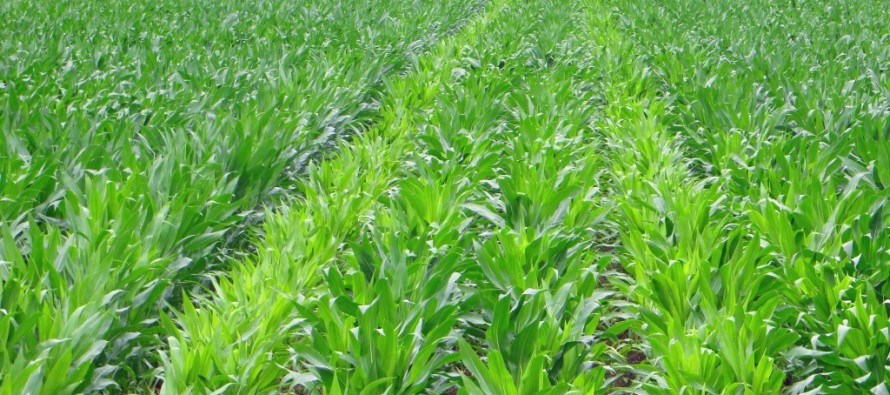Tire Traffic Soil Compaction Effects on Corn

 As a lot of our corn progresses through rapid vegetative stages approaching tassel, issues associated with soil compaction are becoming more evident. Soil compaction resulting from early season tire traffic is widespread this year throughout the Delta and other regions. A considerable degree of soil compaction is understandable considering this spring’s frequent rainfall restricting opportunities during prime planting time, which incited planting and other field activities when soil was moister than desired. Therefore, we are seeing more of these compaction issues than normal.
As a lot of our corn progresses through rapid vegetative stages approaching tassel, issues associated with soil compaction are becoming more evident. Soil compaction resulting from early season tire traffic is widespread this year throughout the Delta and other regions. A considerable degree of soil compaction is understandable considering this spring’s frequent rainfall restricting opportunities during prime planting time, which incited planting and other field activities when soil was moister than desired. Therefore, we are seeing more of these compaction issues than normal.
 As these issues become more apparent, questions arise regarding how much this may affect the crop and its yield potential. The most visible effect now is vegetative stunting associated with soil compaction. This stunting will permanently limit plant height, since corn has a determinant growth habit, and thus cannot “make up” for restricted development during the season. Yellow or other abnormal leaf color associated with these tire traffic patterns is also common – which is often associated with nitrogen deficiency. Nevertheless, soil compaction severely restricting crop root development is still the primalry issue, and can limit availability of most nutrients – not just nitrogen. The Monsanto Learning Center at Scott, MS completed some interesting demonstrations documenting the effects of soil compaction resulting from tire traffic on multiple crops a few years ago which we are thankful to share.
As these issues become more apparent, questions arise regarding how much this may affect the crop and its yield potential. The most visible effect now is vegetative stunting associated with soil compaction. This stunting will permanently limit plant height, since corn has a determinant growth habit, and thus cannot “make up” for restricted development during the season. Yellow or other abnormal leaf color associated with these tire traffic patterns is also common – which is often associated with nitrogen deficiency. Nevertheless, soil compaction severely restricting crop root development is still the primalry issue, and can limit availability of most nutrients – not just nitrogen. The Monsanto Learning Center at Scott, MS completed some interesting demonstrations documenting the effects of soil compaction resulting from tire traffic on multiple crops a few years ago which we are thankful to share.
A few years ago growers questioned Monsanto Agronomists about what crops could be planted in rotation with wheat. The photo at the right is the result of a trial where corn was planted as a rotational crop behind wheat. The wheat was harvested while the soil was still damp enough to slightly track. Pictured to the right is the results of the compaction created by the combine.
 This graph shows the degree of soil compaction in tire traffic rows (blue line) compared to non-traffic rows (green line) at different depths from the Monsanto Learning Center demonstration shown in the photo above. In this example, severe soil compaction was evident in tire traffic rows at depths from 3-8 inches and also deeper than 12-13 inches. Roots have great difficulty penetrating pressures greater than 300psi.
This graph shows the degree of soil compaction in tire traffic rows (blue line) compared to non-traffic rows (green line) at different depths from the Monsanto Learning Center demonstration shown in the photo above. In this example, severe soil compaction was evident in tire traffic rows at depths from 3-8 inches and also deeper than 12-13 inches. Roots have great difficulty penetrating pressures greater than 300psi.
 Soil compaction resulting from tire traffic on wet soil is going to restrict root development, stunt crop development and ultimately limit corn yield. Limited root development will limit uptake of nutrients, water and perhaps other resources critical to crop productivity. The Monsanto Learning Center estimated an average corn yield loss of 63 bu./a. resulting from severe compaction associated with various cropping systems in this demonstration, including furrow irrigated, dryland, and center-pivot (sprinkler) irrigated. Although there is little we can do to mitigate the negative effects of tire traffic soil compaction during the season, we should be more aware of the associated consequences, and given a little opportunity from Mother Nature, strive to plant during better conditions in the future.
Soil compaction resulting from tire traffic on wet soil is going to restrict root development, stunt crop development and ultimately limit corn yield. Limited root development will limit uptake of nutrients, water and perhaps other resources critical to crop productivity. The Monsanto Learning Center estimated an average corn yield loss of 63 bu./a. resulting from severe compaction associated with various cropping systems in this demonstration, including furrow irrigated, dryland, and center-pivot (sprinkler) irrigated. Although there is little we can do to mitigate the negative effects of tire traffic soil compaction during the season, we should be more aware of the associated consequences, and given a little opportunity from Mother Nature, strive to plant during better conditions in the future.
We gratefully acknowledge Monsanto and the Monsanto Learning Center at Scott, MS for permission to reference materials cited.





Let me tell You a sad story ! There are no comments yet, but You can be first one to comment this article.
Write a comment